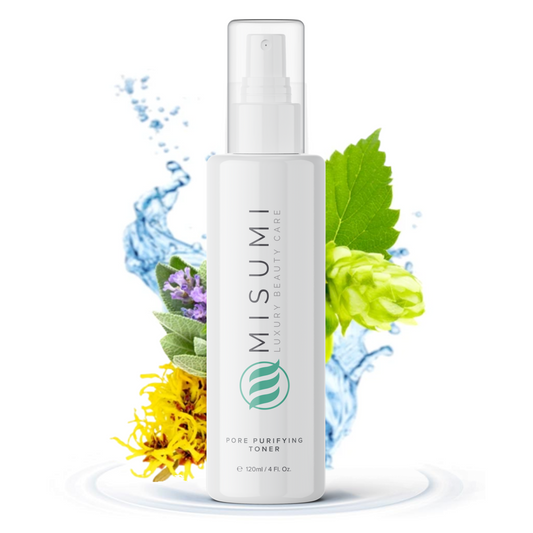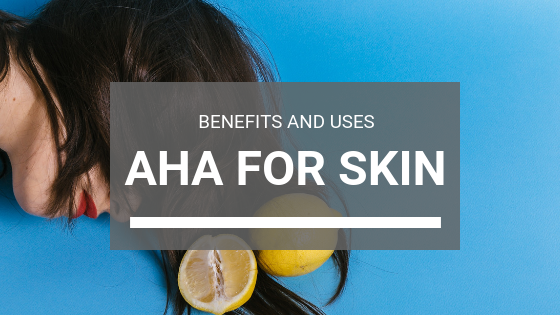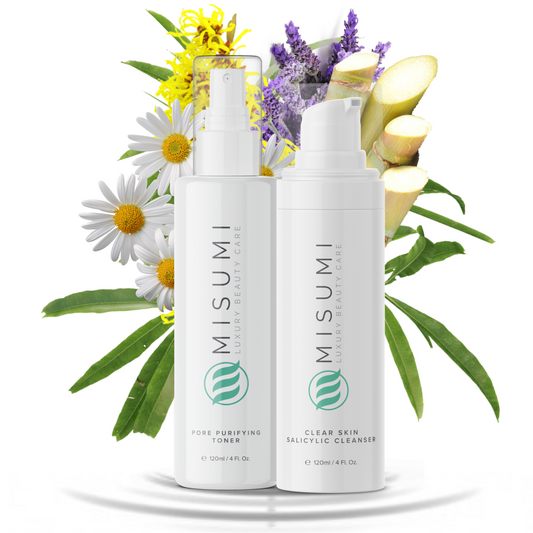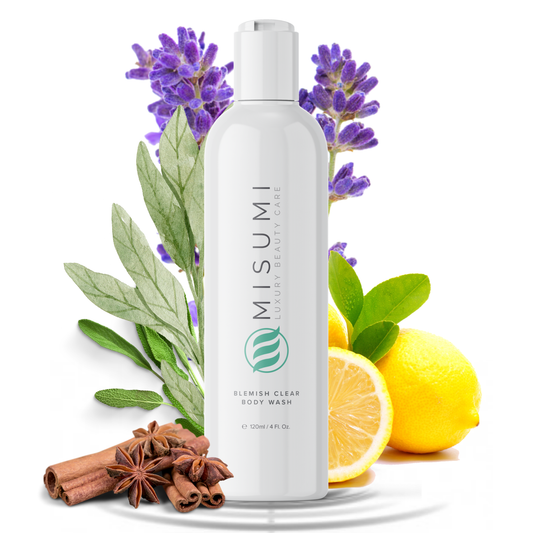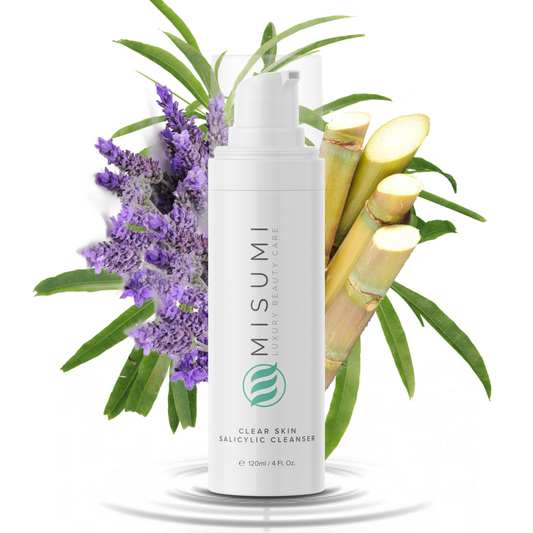All we have to do is look around to see how many exfoliating products use AHAs for various skin conditions. So, it’s only logical that some of the most frequently asked questions regarding skincare are, “What exactly is AHA? What are the benefits of using AHA on your skin?"
We’re here to shed some light on these three mysterious, skin-healing letters. So, let’s dive in.
What Exactly is AHA?

Let’s put on our science hats for a little bit. AHA stands for "alpha hydroxy acids," a group of organic carboxylic chemical compounds naturally found in several foods and plants.
They have profound effects on the epidermal and dermal layers of the skin, diminishing the cellular cohesion between corneocytes at the lowest levels of the stratum corneum in the epidermis. They also increase the production of mucopolysaccharides and collagen in the dermis. And they do all of this without causing inflammation.
Still with us? Let’s put this in simpler terms.
What Does AHA do to the Skin?
Alpha hydroxy acids are a group of chemicals that have a powerful effect on the top two layers of our skin. AHA can easily shed dead skin cells from the skin’s surface and penetrate a little deeper, reaching the dermis.
Why is this important?

Well, did you know our skin’s epidermis is avascular (meaning it doesn’t contain any blood vessels), while the dermis is vascular? The ability to penetrate the skin’s surface and reach the living cells within the dermis is crucial. It means the active ingredients in the acid act to stimulate collagen production.
This is why these chemical exfoliants are more effective than most physical exfoliators and scrubs that only work on the surface.
The above-mentioned characteristics of AHAs make them a suitable ingredient in products with anti-aging benefits, like removing scars, surface wrinkles, and brown spots, lightening discolorations and correcting uneven skin tone, tightening the face, and improving the overall appearance of your complexion.
Is AHA Different From BHA?

If you’ve already heard about AHA, you are inevitably familiar with another powerful three-letter ingredient in many skincare products. And, yes, even though these chemical compounds are close cousins, they're very different in how they act and the benefits they can bring you.
BHA stands for beta hydroxy acid, or more specifically - salicylic acid, which is the only BHA used in cosmetics. There are many salicylic acid products out there, from moisturizers to amazing acne-busting cleansers.
One of the biggest differences is that AHAs are water-soluble acids, whereas beta hydroxy acids are oil-soluble.
Unlike AHAs, beta hydroxy acids have greater bioavailability, penetrate the layers much deeper, and are best for oily skin and acne-prone skin types. If you want to learn more about the differences between AHAs and BHAs and how they're used, check out this article.
AHAs Used in Cosmetics
Glycolic Acid

Glycolic acid is derived from sugar cane. Not only does it belong to the big AHA family, but it’s also the superstar among them. It’s considered the most used and studied acid in the skin care and beauty world.
Glycolic has earned this reputation by having the smallest molecules and the greatest bioavailability of all the AHAs. This puts it as the most effective, but also the strongest and irritable, acid in the family.
Depending on the concentration and pH value of the product, you can find the right fit for your skin type and use this acid for deep exfoliation. Many products, such as glycolic acid peels, can help smooth skin texture and brighten skin tone.
The Benefits of Using Glycolic Acid in Skin Care
Apart from unclogging pores and removing dead skin cells, glycolic has several anti-aging benefits, including reducing wrinkles, lines, and dark spots. It can also increase collagen production and contribute to face tightening, preventing damage from aging and dry skin.
Because this acid is really strong, it is also effective in reducing acne and preventing new acne breakouts. In general, most products only contain 7 - 30 percent glycolic acid.
Lactic Acid

Now you've discovered glycolic acid is everything you’ll ever need in your skincare routine, you might be wondering why brands would use another AHA in their products. The truth is not every skin type can handle the strength of glycolic acid. This is why lactic acid is the best alpha hydroxy acid for sensitive skin types.
Lactic acid is naturally found in milk. It sloughs old skin cells, clears the complexion, and eliminates discoloration and superficial lines without causing irritation.
The Benefits of Using Lactic Acid in Skin Care
Both glycolic and lactic acids are liquid exfoliants that work by breaking down and dissolving the structure of dead skin cells. Only lactic acid does it without causing skin sensitivity.
Its molecules are a little bigger in size, decreasing the bioavailability of lactic acid. This might not be as effective in treating acne and scars or battling deep wrinkles.

Other Acids:
Citric Acid
Citric acid, as the name suggests, is found in citrus fruits and has amazing astringent properties. It will remove dead skin cells and speed up the process of new cell turnover.
Additional benefits associated with citric acid include reducing the appearance of age spots, acne scars, superficial wrinkles, and discoloration. But be careful before using citric acid at home because it can be strong and cause burning, itching, and redness.
Malic Acid
Malic acid is found in apples, and it’s often used to give some foods and drinks a tart taste. However, you can also find it in many shampoos, body lotions, nail treatments, and some acne and anti-aging products. Using malic acids can help you hydrate the face, exfoliate and remove dead skin cells, giving you a smoother texture and improving overall skin health and tone.
Mandelic Acid
Mandelic acids are more gentle on human skin than other AHAs. So if you're looking for an alpha hydroxy acid that offers a gentle exfoliation of the skin barrier, mandelic acid might be your best bet. It can regulate sebum production, soothe inflamed skin and unclog pores.
Tartaric Acid
Tantric acid is found naturally in bananas and grapes and is also one of the chief acids in wine. It's great because it has powerful antioxidants that can clear the complexion, smooth your face, and enhance your skin's natural glow. It’s believed to have the same benefits as lactic and glycolic acid, but the research to back up these claims is still lacking.

Research on AHAs In Skincare
Being as popular as they are, it comes as no surprise that there’s been a lot of research regarding alpha hydroxy acids (AHAs) in skin care products.
In a study from 2014, researchers concluded that using anti-aging skincare products containing alpha hydroxy acids and vitamins significantly improves overall skin health, including wrinkles. It can also improve skin texture, as well as elasticity. It also comes without significant adverse effects.
A review on the efficiency of AHAs used in cosmetic products concluded that they lead to exfoliation, can thicken the epidermis and dermis, and improve the properties of the skin’s water barrier. Additionally, research also showed that the skin becomes more tensile, firmer, smoother, and more youthful looking after the use of products containing AHAs.
And, if you need more, in another review from 2013, researchers evaluated data and studies on glycolic and the effectiveness of this acid in treating various skin concerns. After careful observation, they concluded that using this acid is a simple, evidence-based, result-oriented, and cost-effective procedure that might produce better results when combined with other treatments.
This is not the first time science has weighed in on the beneficial effects of using this alpha hydroxy acid. In fact, studies dating back to 1996 have provided evidence that glycolic acts as an antioxidant and accelerates the resolution of erythema.
Quick note - You may have come across hyaluronic acid in skincare. But please note that hyaluronic isn't an alpha hydroxy acid or even a beta hydroxy acid (like salicylic acid). It's its own thing.

AHA Benefits and Uses
AHAs Offer Deep Exfoliation

AHA Benefits and Uses
AHAs Offer Deep Exfoliation
Deep exfoliation is the primary reason for using AHAs in the first place. It also leads to lots of other skin care benefits.
External pollutants and makeup residue can quickly lead to clogged pores and debris build-up.
On top of that, as we age, our skin’s cell renewal cycle slows down, which means dead skin cells build up on the skin’s surface easily. All this contributes to the development of dark spots, discoloration, wrinkles, and even acne.
AHAs will take care of this problem. They are extremely effective in loosening the bonds between cells, which can help get rid of debris. This way, they make space for the new and undamaged cells to emerge on the surface, and, as a result, your face will appear fresh and glowing.

AHAs Boost Circulation
We mentioned that AHAs can penetrate deeper and reach the dermis. But they also have anti-inflammatory properties, which can improve blood flow. The increased blood flow gives the skin access to more nutrients and oxygen.
AHAs Reduce Discoloration
This benefit is associated with and facilitated by the exfoliation properties of alpha hydroxy acids.
When skin cells and debris are removed from the surface, a new and fresh layer of skin is exposed. The new skin cells are unpigmented and undamaged, and these can give you brighter skin. In other words, the new skin revealed beneath will be more radiant, making alpha hydroxy acids a recipe for a glowing look.

The only concern worth mentioning is that the newly exposed cells will be vulnerable to damage - especially sun damage. This is why it's really important to apply sunscreen when you leave the house and minimize sun exposure where possible. (Psst... this is something you should be doing anyway if you want to properly care for your skin).
AHAs Boost Collagen Production
If you want your face to be tighter and look fresh and smooth without wrinkles or fine lines, you need your collagen. Collagen is a key fiber that gives the skin elasticity and makes it look plump and smooth.
But, as we age and expose ourselves to direct sunlight, the production of collagen slows down. This leads to dull, dry, and saggy skin, which accelerates the formation of wrinkles.
Collagen can be found in the dermis - and we already know that AHAs can reach the dermis. Alpha hydroxy acids help collagen regeneration by destroying old collagen fibers, making way for new cells and healthier skin.

AHAs Reduce Wrinkles and Fine Lines
Many skin care products marketed for their anti-aging properties and reduction of wrinkles and fine lines use AHAs in their formulation. This is because science has proven AHAs work - and on numerous occasions. The fact that glycolic can reduce the appearance of wrinkles and fine lines and prevent new wrinkles from forming is especially well-researched.
AHAs penetrate the skin and stimulate collagen production, increasing cell turnover. These changes help the skin heal much faster and regenerate itself more efficiently, reducing the formation of lines and wrinkles.
It’s important to note that AHAs only work for surface lines and wrinkles, not deeper ones. For deep wrinkles and acne scars, we recommend consulting a dermatologist and getting a professional chemical peel, a filler, or laser resurfacing treatment.

AHAs and Acne Prevention
Although the better option for oily and acne-prone skin are BHAs because they penetrate deeper, work specifically on the sebaceous glands, and dissolve the excess oil, research shows that AHAs can also be effective against mild acne.
The weight of this claim falls on glycolic as the strongest acid of the AHA family.
The exfoliating properties of AHAs can decongest pores. With regular use, they can also prevent future debris buildup and cell clogging from occurring. So, if you’re facing comedogenic acne (acne caused by the clogging of cells), AHAs will help you keep those breakouts at bay.
Sme AHA products containing citric or malic acid can help soothe the inflammation.
AHAs Boost Product Absorption
One of the best things about AHAs is that they will make your skincare products more effective. But how?

The answer is very simple - by exfoliating and removing the outer layer. Sometimes your moisturizer can’t reach living cells and actually hydrate them because there are a ton of dead skin cells on the surface of your face. Applying an AHA product will effectively dissolve all the old cells and allow your favorite product to work its way deeper into the layers. This is how AHAs contribute to better absorption of other skincare products.
AHA Side Effects
Before heading down to AHA products' uses, we should warn you about the possible side effects. Because no, we’re not that fortunate to have found such amazing and effective ingredients that come with no side effects whatsoever.
The first thing you should be careful of when using an AHA product is its concentration and pH value. Too low a pH and high a concentration can cause more damage than good. Always start with gentler products.
If you're using AHA for the first time, you might experience a temporary burning sensation, itching, and redness.
Additionally, AHAs will make you sensitive to sunlight and prone to sun damage. Never leave your house without applying sunscreen. Experts advise using sunscreen daily for at least two weeks after you have stopped using AHAs.

How to Choose the Right AHA Product?
Choosing the right product can be the difference between dull, problematic skin and flawless skin.
So, how to choose?
There are a few things to consider.
pH Value and Concentration
The first thing is the pH value and concentration of the product. The concentration alone might not give you much information because a product with a neutral pH value won’t be as effective as less concentrated products with a low pH value.
Acid Type
The second thing to consider is the type of acid used.
If you’re using AHAs for the first time or have sensitive skin, go for a less concentrated, low to neutral pH value product using lactic acid. But, if you're dealing with more severe symptoms and really want to hit hard, opt for more concentrated, low-pH value products that contain glycolic as their active ingredient.
If you're using over-the-counter products, a safe concentration would be less than 10%, with a pH value higher than 3.5. Some professionals in beauty salons can use products that contain up to 30% of acid and have a pH value higher than 3.

How to Introduce AHAs and BHAs Safely
To ensure you receive all the benefits of alpha hydroxy acids, you must follow these safety measures.
- Always patch-test a product before using it on your face. Apply a small amount of the product on a patch of your skin and wait to see how you react.
- Start with gentle, low-concentrated products. The best starter acid is lactic acid. Look for products with an AHA concentration of less than 10%.
- In the beginning, use the product only once a week. After a few weeks, you can slowly increase the frequency of application. Remember that this also depends on the strength and concentration of the product. Less concentrated products are safe for daily use, while you should use more concentrated products once or twice a week.
- After exfoliating with an AHA product, finish your skincare routine with a gentle and nourishing moisturizer filled with vitamins to feed and protect you.
Quick tip - These safety measures aren't just important for alpha hydroxy acids. Keep them in mind when using both AHAs and BHAs (or salicylic acid).
Conclusion

If you want to exfoliate, get a more glowing complexion, and reduce common imperfections on the skin’s surface, then AHAs are here for you. You can find them in creams, lotions, toners, and other acne or anti-aging products.
Depending on your skin type and condition, you can choose from various acids in the AHA family. The most famous and commonly used are glycolic, followed by lactic acid, an alternative for people with sensitive skin.
There’s heavy research supporting the benefits associated with the use of AHA. Avoid products that might be too concentrated and strong, as these can cause damage. Start slowly and gently, and after you give your face time to adjust, increase the strength or frequency.
Conclusion
Photoprotective and anti-inflammatory effects of topical glycolic acid
